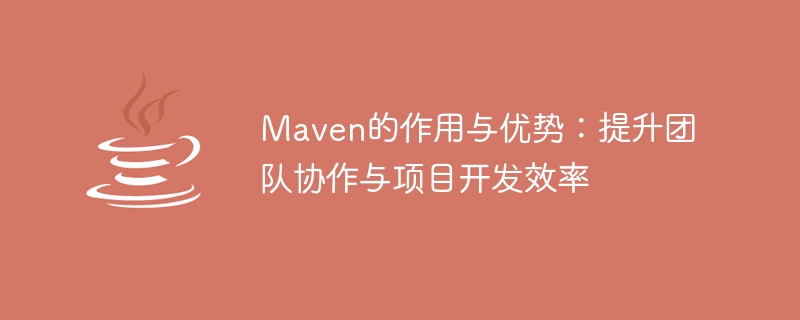
The role and advantages of Maven: improving team collaboration and project development efficiency
Introduction:
In the software development process, project management and collaboration are crucial important. A good project management tool can provide efficient collaboration among team members and help project developers better organize and manage projects. In this regard, Maven is a very popular tool, which not only helps project developers better manage projects, but also improves development efficiency. This article will introduce the role and advantages of Maven, and explain in detail how to use Maven to improve team collaboration and project development efficiency.
1. The functions and characteristics of Maven
Maven is a tool used to build and manage software projects. It helps developers follow a development methodology called "convention over configuration." Specifically, Maven can complete the following aspects of work:
- Project construction and management: Maven can define the structure, dependencies and build process of the project through the configuration file (pom.xml). Execute the corresponding commands to automatically complete the construction and packaging of the project.
- Dependency management: Maven can automatically download and manage third-party libraries and tools that the project depends on. Developers only need to declare dependencies in the configuration file, and Maven can automatically download and introduce these dependencies.
- Project documentation and reports: Maven can automatically generate project documents and reports, such as API documentation, test reports, etc. These documents and reports can be easily shared and viewed with team members, improving team collaboration efficiency.
- Project release and deployment: Maven can help developers publish projects to local or remote warehouses for the convenience of other developers. At the same time, it can also support automatic deployment of projects, simplifying the project deployment process.
2. Advantages of Maven
- Simplifying project management
Maven simplifies the project configuration and management process by providing a set of structured project management methods. Developers only need to follow the convention and organize the project structure and configuration files according to Maven's requirements to enjoy a series of functions provided by Maven. In this way, the project management process among team members is more standardized and unified, reducing personal troubles and misoperations.
- Improve team collaboration efficiency
Maven provides a unified dependency management mechanism. Developers only need to declare the libraries and tools that the project depends on in the configuration file, and Maven can automatically download and introduce these dependencies. In this way, team members can better share the project's dependency management configuration, without everyone having to download and introduce dependencies manually. This greatly improves collaboration efficiency among team members while reducing errors during project build and deployment.
- Reduce development costs
Maven provides a large number of plug-ins and extensions that can be easily integrated into various development environments. At the same time, Maven also provides rich documentation and tutorials to help developers get started and use it faster. In this way, team members can master and use Maven faster, reducing the cost of learning and use.
3. How to improve team collaboration and project development efficiency
- Training and knowledge sharing
For team members, being familiar with the use of Maven is the key to improving team collaboration efficiency premise. Therefore, the team can organize Maven training and knowledge sharing activities so that every member can master the basic operation and use skills of Maven. At the same time, the team can establish a set of documents and examples to guide and standardize developers' use of Maven.
- Uniform project structure and configuration
The structure and configuration of the project are important prerequisites for Maven to work properly. Therefore, the team should develop a unified set of project structure and configuration specifications and use them as the team's conventions and specifications. In this way, when team members develop new projects, they only need to organize the project directory and configuration files according to the specifications, and they can quickly get started and use Maven.
- Continuous integration and automated testing
Maven can be integrated with continuous integration tools (such as Jenkins) and automated testing frameworks (such as JUnit) to achieve continuous integration and automated testing. By configuring corresponding plug-ins and scripts, various tests and checks can be automatically performed during code submission or build. In this way, the team can discover and fix problems in the code in time, improving the quality and stability of the project.
Conclusion:
As a powerful software project management tool, Maven can help teams improve collaboration efficiency and project development efficiency. With unified project structure and configuration, team members can collaborate better and reduce development costs and errors. At the same time, Maven also provides functions such as dependency management, project release and deployment, which improves development efficiency and project quality. Therefore, the team should actively use Maven and improve team members' mastery and use of Maven through training and knowledge sharing.
The above is the detailed content of Improve team collaboration and project development efficiency: Understand the functions and benefits of Maven. For more information, please follow other related articles on the PHP Chinese website!






